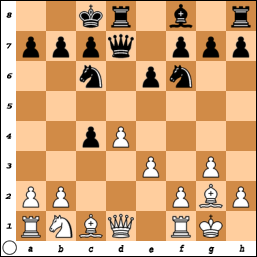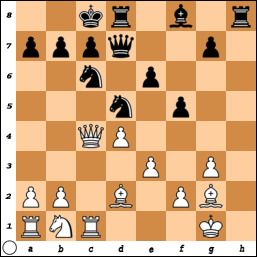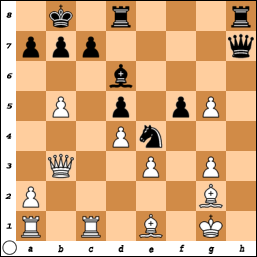While watching the live transmission of the US Championship a couple of weeks ago, I noticed the following game which followed one of the new lines in Grandmaster Repertoire 1A – The Catalan. In the game White went wrong and lost badly, so I was keen to see how the game compared with Boris’s analysis.
A. Sharevich – K. Nemcova
Saint Louis 2015
1.d4 Nf6 2.c4 e6 3.g3 d5 4.Nf3 dxc4 5.Bg2 Bd7 6.Ne5 Bc6 7.Nxc6 Nxc6
This line never used to have the best reputation for Black, but in the years since GM 1 was published it has undergone something of a resurgence thanks to an interesting plan involving long castling.
8.0–0 Qd7 9.e3 0–0–0!?
This is the fashionable way to handle Black’s position. The database contains one email game from 2003, but apart from that, every game has been played from 2009 onwards.
In GM 1 Boris gave 9…Rb8 as the main line, while also considering the sidelines 9…e5 and 9…Nd5. Obviously these lines are also given with updated analysis in the new book.

10.Qa4
Boris mentions that he initially liked 10.Nd2 for White, when the most popular line 10…h5 11.Nxc4 is indeed promising for him.
However, he changed his mind after examining 10…e5!, after which Black’s position proved fine in Giri – Harikrishna, Biel 2014. The fact that such a well-prepared super-GM as Giri failed to prove an advantage shows how seriously this line should be taken.
10…Nd5
10…h5 is less accurate, as Boris demonstrates in the book.
11.Qxc4 h5 12.Bd2!
So far Sharevich is doing everything right.
12.Nc3 has been played more frequently, but it is more important to get a rook to the c-file and advance the b-pawn.
12…h4 13.Rc1 hxg3 14.hxg3 f5

15.Nc3
The strongest continuation is: 15.b4! Bd6 Avrukh demonstrates in his book that capturing the pawn is dangerous for Black. 16.b5 Nce7 17.Nc3 Kb8 18.a4 White went on to win in Swinkels – Polaczek, Germany 2013. Compared to the main game, the queenside attack is much more advanced. Boris goes on to provide an improvement for White a few moves later; further details can be found in the book.
15…g5 16.Qa4 Kb8 17.Nxd5 exd5 18.b4?!
18.Rc2 prepares to double on the c-file, and after the natural 18…Ne7 19.Qxd7 Rxd7 the queenless position is about equal. Considering the course of the game, White should have settled for this.
18…Bd6 19.b5?
White should have tried 19.Bxd5 Bxg3 20.Bxc6 bxc6 21.Qxc6, when Black does not seem to have anything decisive, although there is no question of White getting more than a draw.
19…Ne7 20.f4?
White was already in trouble due to the threat of …f4, but the game continuation fatally weakens her kingside.
20…Ng8! 21.Qb3 Nf6 22.fxg5 Ne4 23.Be1 Qh7
The rest of the game is painful to watch, as White takes a savage mauling.

24.Qxd5 Bxg3 25.Qe6 Nxg5 26.Qc4 Bxe1 27.Rxe1 Ne4 28.Qc2 Rdg8 29.Rac1 Qh1#
0–1
Conclusion
The Catalan is still an excellent opening, but there are plenty of double-edged lines where things can go badly wrong for White after inaccurate play. GM 1A shows how to get the absolute best out of the Catalan, while avoiding the sort of thing that happened in the above game.
Ah chess – I remember discovering this idea for Black after Avrukh’s book was published and I was so happy – but I never got the chance to use it in a game. Now to do so would probably be suicide.
Today Avrukh lost a game in the slav against Moisenko.
Time to change the salespitch for his Slav book.
Avrukh and Postny are not the same person I think.
Just repeating this because it is so cool :-).
Wasn’t even Avrukh’s recommended 4th move (a6 instead of dxc4)…
But it would be fun if Boris lost a “serious game” in the Slav at some point (maybe against Carlsen :-D) – you’d have to reword the foreword 😉
And chess was supposed to keep our minds sharp 🙁
Reminded me of Misha Glenny’s : There are two types of companies in the world: those that know they’ve been hacked, and those that don’t.
The “never” pitch is always dodgy, as it never tells the whole story.
Main reason it annoyed me is that chess is about battling imperfection, and not about being perfect.
anyway, no hard feelings, as I have immensely enjoyed the d4 Avrukh books.
@aspiJ
The banter is always welcome 🙂
GM 17 on p. 310 where Avrukh recommends the 15…Qe7!?N is bad because of 16. Na2 Nd6 17. Bd3 Ba5 and then 18. f4!
@Yohan
Opening books are out of date after a few days they are released… (or maybe before released), that’s life 🙂
GM17 must be the best opening book ever written. It is simply stuffed with nice tactical ideas. I have never played the Slav before but I’m looking so much forward to trying it in a tournament the next couple of days.
@Fer
I think you will find that things move quite a bit slower than that.
Sorry Jacob, I have to agree with Fer. I can just point you to a 2 cases about Negi’s first GM Rep book.
French Line 7.Be3 cxd4 8.Nxd4 Qb6.
There is a big hole in the book. – Chapter 10 Line B223 – 21…Rb8 is simply a draw – I’ve checked it a lot with computer and white simply has nothing, while Negi states he is slightly better and that move is not main line.
Same line B2) – 16.Qf2 – funny comment by Negi: “”Karjakin opted for 16.Qf2 against Agdestein, but failed to achieve anything special and later had to fight hard for a draw.”
Sorry guys, I think Karjakin simply forgot his home work (16.Qf2 and brilliant 17.g3). In that game 22.Bd6!! simply puts Black out of business and thus throwing the whole line with 8…Qb6 out of business.
@Milen Petrov
There are many more holes in that book and even more holes in other books. Some books (not QC books) are more holes than variations! You have to take those books as a skeleton to build your own repertoire with your own judgement and preferences. With enough time and willpower you will find holes in every book. A book is good if it remains so even after holes are discovered and in this sense Negi’s book is one of the best ever.
@Milen Petrov
Not commenting on the lines in question (not wanting to check them, so I will just take you at your word) – but sorry, this is just not what he said.
He said a book would be outdated at publication, essentially, which I have heard before. theory just does not move that quickly. Most of the lines that were critical a few years ago are still critical.
However, if you say that there are mistakes in our books or that there are more things to be found, I certainly agree. We do not try to give the impression that our books are the last word at all. There will be mistakes in our author’s analysis for sure and you probably have found one. But there is a difference from the way other publishers approach this issue, which is one of indifference to the quality of analysis, trusting the authors blindly on getting all the lines in there (which never happens) and presenting the work as if it is the final word on a line.
But all of this is about the quality of the analysis. This line might not be played for the next three years and the chapter will remain as relevant – or as wrong – as it was on publication. To say that serious parts of the book are no longer relevant now is obvious nonsense. So, I will stick to my gun on the argument.
@Jacob Aagaard
You’re right. I play his Slav reportoire and it is simply fantastic!
@garryk
Good points! What sets Negi’s books apart from the rest are his splendid explanations. Even if some lines are improved by black (which is simply inevitable) the explanations keep their value. For this reason I don’t only put the moves in my databases, but also all commentary. It’s some work, but I noticed it really pays off (by the way, this is also recommended by Axel Smith in his book).
@Jacob Aaggaard I didn’t want to say that the whole book or ideas were out-of-date, I’m glad with GM repertoire books, and I’m sure that 99% chess players over 2000 elo would agreed that they are the best chess openings books you can buy (also if you have time to study :))
I just wanted to answer to Yohan, that shows a concrete line, that can be improved. Chess is alive, so these things happend, fortunately!!
@Fer
I would guess that after 6 months there are far more mistakes than outdated things in any theory book. By a large counter even!
Today I received my hardcover copy. Impressed 🙂
But what worries me is line 1.d4 Nf6 2. c4 c5, or 1.d4 c5?
How come that these lines aren’r included? Or there will have separate coverage in forthcoming volumes?
Lastly, in GM Rep 1 Avrukh used QGD move order: 1.d4 d5 2.c4 e6 3.Nf3 Nf6 and only now 4.g3? Why this change?
Thanks for reply 🙂
@LE BRUIT QUI COURT
After 1. d4 c5 you play 2. e4 – QC has published a nice book on this.
Just kidding. It’s just a different thematic structuring of lines. The mentioned lines will be part of another book.
@Milen Petrov:
At least this French line is not a secret – for one thing, the line up to and beyond 22.Bd6 is analyzed in Lakdawala’s new book on the Classical French (you know, those untheoretical opening books meant for beginners from a certain non-Glasgow-based publisher ;-))
The american IM claims 15…Qd8 is safer, as Agdestein played against Grischuk in the same tournament.
@LE BRUIT QUI COURT
It will be four volumes. We cannot put everything in volume 1!
Boris felt it worked better with the other move order, to include the Bogo-Indian. But in reality both of them lead to the same position, so it really does not matter!
The variation (in Sharevich – Nemcova) mentioned by Andrew in the beginning if this thread is interesting also from the point of view that NewInChess Magazine 2015/4 has an SOS article about this variation.
Jerpen Bosch then specifically mentions Avrukhs recommendations in Catalan 1A) and claim to have a solution for Black based on 12.Bd2 h4 13.Rc1 hxg3 14.hxg3 f5 15.b4 and now not 15…Bd6, 15…Ncxb4 or 15… Bxb4 – but 15…g5!?.
He then “go into more analytical then I normally would do in an SOS-article” as he thinks he has a major improvement.
I understand it is not possible to comment on new ideas before they appear but as the above will be read by many and potentially used a lot against Catalan 1A) players it would be great if possible to get a comment on the above.
@Snoka
I’m studying this line right now, and I must say 15…g5!? seems like a tough nut to crack. Stockfish keeps on arriving at ‘0.0’ (lots of perpetuals) … Looking forward to the next update 🙂
@Ray 15…g5!? is a draw, whole chapter is busted. These things happen though 🙂
10.Nc3 is the new battlefield in this line.
@trandism
Thanks! I also looked on Chesspublishing.com yesterday and according to Illingworth 6.Nbd2 more or less refutes the whole line with 5…Bd7. Do you have any views on that?
I think that Illingworth was a bit sloppy on that. The line 6.Nbd2 Bc6!? 7.Nxc4 Bd5 seems to equalise for Black rather easily.
Coming from Nik I’m pretty sure this is enough for equality and generally speaking I find it hard to believe than 6.Nbd2 can put this 5…Bd7 in danger, it doesn’t feel logical that the critical line is this one.
I have found some things in the 10.Nc3 line combining ideas from a couple of people and also an IDEA project I’m running, but still not sure if there is a real edge there. More analysis – and more CPU cycles needed.
@ Nikos and trandism:
Thanks you both, this gives me enough guidance to continue my own research 🙂
GM repertoire 2 has a big big hole in it – 1.d4 e6 2.c4 Bb4+. The material on 1.d4 e6 2.c4 b6 transposes into some lines (but only Bxd2+ and Qe7 after 3.Nf3 Bb4+ 4. Bd2) but there are also independent lines eg 1.d4 e6 2.c4 Bb4+ 3.Bd2 a5 or 1.d4 e6 2. c4 Bb4+ 3.Bd2 Bxd2+ 4.Qxd2 Nf6 5.Nc3 0-0 6. Nf3 (6.e4 d5) d5 with several completely different set ups. This is very disappointing. I expected a full repertoire.
@Slevin
Will an update be forthcoming?